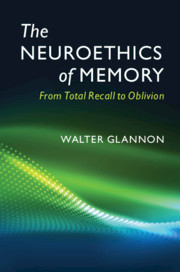Book contents
- The Neuroethics of Memory
- The Neuroethics of Memory
- Copyright page
- Dedication
- Contents
- Figures
- Acknowledgments
- Introduction
- 1 Memory Systems and Memory Stages
- 2 Agency, Identity and Dementia
- 3 Anesthesia, Amnesia and Recall
- 4 Disorders of Memory Content and Interventions
- 5 Disorders of Memory Capacity and Interventions
- 6 Legal Issues Involving Memory
- Epilogue
- References
- Index
1 - Memory Systems and Memory Stages
Published online by Cambridge University Press: 18 July 2019
- The Neuroethics of Memory
- The Neuroethics of Memory
- Copyright page
- Dedication
- Contents
- Figures
- Acknowledgments
- Introduction
- 1 Memory Systems and Memory Stages
- 2 Agency, Identity and Dementia
- 3 Anesthesia, Amnesia and Recall
- 4 Disorders of Memory Content and Interventions
- 5 Disorders of Memory Capacity and Interventions
- 6 Legal Issues Involving Memory
- Epilogue
- References
- Index
Summary
This chapter traces the evolution of human memory from Aristotle’s theory of recollection to current versions of Frederic Bartlett’s theory of memory as a reconstruction rather than reproduction of the past. Through constant updating of its content, memory serves an adaptive purpose. The chapter describes Endel Tulving’s definition of what memories are and outlines Larry Squire’s taxonomy of declarative and nondeclarative memory. It describes the stages of the memory process, the brain regions that mediate them and how they become dysfunctional in disorders of memory capacity and content. The reconstructive model serves as a theoretical framework for discussing metaphysical, ethical and legal issues regrading normal and abnormal memory, as well as interventions to improve, restore, weaken or erase memories.
Keywords
Information
- Type
- Chapter
- Information
- The Neuroethics of MemoryFrom Total Recall to Oblivion, pp. 14 - 49Publisher: Cambridge University PressPrint publication year: 2019
